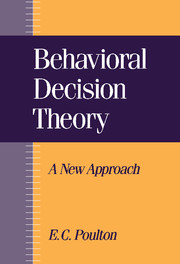Book contents
- Frontmatter
- Acknowledgments
- Contents
- Preface
- Chapter 1 Outline of heuristics and biases
- Chapter 2 Practical techniques
- Chapter 3 Apparent overconfidence
- Chapter 4 Hindsight bias
- Chapter 5 Small sample fallacy
- Chapter 6 Conjunction fallacy
- Chapter 7 Regression fallacy
- Chapter 8 Base rate neglect
- Chapter 9 Availability and simulation fallacies
- Chapter 10 Anchoring and adjustment biases
- Chapter 11 Expected utility fallacy
- Chapter 12 Bias by frames
- Chapter 13 Simple biases accompanying complex biases
- Chapter 14 Problem questions
- Chapter 15 Training
- Chapter 16 Overview
- References
- Index
Chapter 10 - Anchoring and adjustment biases
Published online by Cambridge University Press: 06 July 2010
- Frontmatter
- Acknowledgments
- Contents
- Preface
- Chapter 1 Outline of heuristics and biases
- Chapter 2 Practical techniques
- Chapter 3 Apparent overconfidence
- Chapter 4 Hindsight bias
- Chapter 5 Small sample fallacy
- Chapter 6 Conjunction fallacy
- Chapter 7 Regression fallacy
- Chapter 8 Base rate neglect
- Chapter 9 Availability and simulation fallacies
- Chapter 10 Anchoring and adjustment biases
- Chapter 11 Expected utility fallacy
- Chapter 12 Bias by frames
- Chapter 13 Simple biases accompanying complex biases
- Chapter 14 Problem questions
- Chapter 15 Training
- Chapter 16 Overview
- References
- Index
Summary
Summary
When people have an obvious anchor, they may estimate probabilities using Tversky and Kahneman's (1974, p. 1128) anchoring and adjustment heuristic, instead of following the normative rule of avoiding the use of anchors. They play safe and select a response that lies too close to the anchor or reference magnitude. There are 2 versions of the heuristic that correspond to 2 simple biases: the response contraction bias that is discussed in previous chapters, and the sequential contraction bias.
The sequential contraction bias version occurs in making a final estimate from an initial reference magnitude. It may be possible to avoid the sequential contraction bias by using only judgments of stimuli following an identical stimulus, by counterbalancing ascending and descending responses and averaging, or by asking for only one judgment from each person, starting from a previously determined unbiased reference magnitude. The sequential contraction bias can be used successfully in selling to and buying from unwary customers. It can bias the comparative evaluation of a number of candidates or rival pieces of equipment. It can lead to unwarranted optimism in planning, and in evaluating the reliability of a complex system. It can be responsible for the conservatism in revising probability estimates.
Response contraction bias and sequential contraction bias versions
When anchors are available, Tversky and Kahneman (1974, p. 1128) describe how people use the anchoring and adjustment heuristic. They do so instead of following the normative rule of avoiding the use of anchors.
- Type
- Chapter
- Information
- Behavioral Decision TheoryA New Approach, pp. 187 - 193Publisher: Cambridge University PressPrint publication year: 1994



